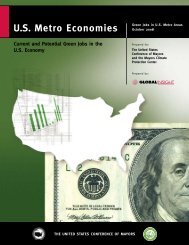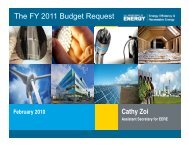IRON AND STEEL SCRAP81Tariff: Item Number Normal Trade Relations12-31-10Iron <strong>and</strong> steel waste <strong>and</strong> scrap:No. 1 Bundles 7204.41.0020 Free.No. 1 Heavy Melting 7204.49.0020 Free.No. 2 Heavy Melting 7204.49.0040 Free.Shredded 7204.49.0070 Free.Depletion Allowance: Not applicable.Government Stockpile: None.Events, Trends, <strong>and</strong> Issues: Hot-rolled steel prices increased steadily during 2010 to a high in April of about $754per metric ton, after which they decreased to $626 per ton in August 2010. During the first 9 months of 2010, prices ofhot-rolled steel were higher than those in 2009. The producer price index for steel mill products increased to 203 inMay 2010 from 153 in May 2009. Steel mill production capability utilization peaked at 75.4% in June 2010 from a lowof 40.8% in April 2009.Scrap prices fluctuated widely between about $290 <strong>and</strong> $367 per ton in 2010. Composite prices published by IronAge Scrap Price Bulletin for No. 1 Heavy Melting steel scrap delivered to purchasers in Chicago, IL, <strong>and</strong> Philadelphia<strong>and</strong> Pittsburgh, PA, averaged about $320 per ton during the first 8 months of 2010. As reported by Iron Age ScrapPrice Bulletin, the average price for nickel-bearing stainless steel scrap delivered to purchasers in Pittsburgh wasabout $2,273 per ton during the first 10 months of 2010, which was 45% higher than the 2009 average price of $1,502per ton. The prices fluctuated widely between a low of $1,711 per ton in January 2010 <strong>and</strong> a high of $2,724 per ton inApril <strong>and</strong> May 2010. Exports of ferrous scrap decreased in 2010 to an estimated 19 million tons from 22 million tonsduring 2009, mainly to China, the Republic of Korea, Taiwan, Malaysia, Turkey, <strong>and</strong> Canada, in descending order ofexport tonnage. Export scrap value increased from $7.1 billion in 2009 to an estimated $8.0 billion in 2010.North America has been experiencing a shortage of iron <strong>and</strong> steel scrap, owing to increased export dem<strong>and</strong>, primarilyfrom China, Turkey, <strong>and</strong> Canada. Even significantly increased prices for scrap have not led to an increase in scrapavailability, because almost all old scrap had been collected from farms, ranches, <strong>and</strong> other sources, <strong>and</strong> recessionhitconsumers have been keeping <strong>and</strong> repairing old appliances rather than disposing of them. Also, manufacturerswere decreasing production, thus producing little new scrap for the scrap market.World Mine Production <strong>and</strong> Reserves: Not applicable.World Resources: Not applicable.Substitutes: About 1.4 million tons of direct-reduced iron was used in the United States in 2009 as a substitute foriron <strong>and</strong> steel scrap, down from 2.0 million tons in 2008.e Estimated. E Net exporter.1 See also Iron Ore <strong>and</strong> Iron <strong>and</strong> Steel.2 Receipts – shipments by consumers + exports – imports.3 Includes used rails for rerolling <strong>and</strong> other uses, <strong>and</strong> ships, boats, <strong>and</strong> other vessels for scrapping.4 Estimated, based on 2002 Census of Wholesale Trade for 2006 through 2010.5 Defined as imports – exports + adjustments for Government <strong>and</strong> industry stock changes.U.S. Geological Survey, <strong>Mineral</strong> <strong>Commodity</strong> <strong>Summaries</strong>, January <strong>2011</strong>
82IRON AND STEEL SLAG(Data in million metric tons unless otherwise noted)Domestic Production <strong>and</strong> Use: Iron <strong>and</strong> steel slags are coproducts of iron- <strong>and</strong> steelmaking <strong>and</strong> find a marketprimarily in the construction center. Although data on U.S. slag production are unavailable, the range of output isestimated as having increased by about 30% to about 11 to 15 million tons in 2010, owing to a restart of many of theiron <strong>and</strong> steel furnaces that had been idled at least part time in 2009. Better slag availability led to a modest increasein slag sales in 2010, although volumes remained constrained by continued low levels of construction spending. Anestimated 15 million tons of iron <strong>and</strong> steel slag, valued at about $290 million 1 (f.o.b. plant), was sold in 2010. Iron orblast furnace slag accounted for about 60% of the tonnage sold <strong>and</strong> had a value of about $250 million; nearly 85% ofthis value was granulated slag. Steel slag produced from basic oxygen <strong>and</strong> electric arc furnaces accounted for theremainder. 2 Slag was processed by nearly 30 companies servicing active iron <strong>and</strong>/or steel facilities or reprocessingold slag piles at about 120 sites in 32 States; included in this tally are a number of facilities that grind <strong>and</strong> sell groundgranulated blast furnace slag (GGBFS) based on imported unground feed.The prices listed in the table below are the weighted, rounded averages for iron <strong>and</strong> steel slags sold for a variety ofapplications. Actual prices per ton ranged widely in 2010 from about $0.20 for steel slags for some uses to about$100 for some GGBFS. The major uses of air-cooled iron slag <strong>and</strong> for steel slag are as aggregates for asphalticpaving, fill, <strong>and</strong> road bases <strong>and</strong> as a feed for cement kilns; air-cooled slag also is used as an aggregate for concrete.Nearly all GGBFS is used as a partial substitute for portl<strong>and</strong> cement in concrete mixes or in blended cements.Pelletized slag is generally used for lightweight aggregate but can be ground into material similar to GGBFS. Owing totheir low unit values, most slag types can be shipped by truck only over short distances, but rail <strong>and</strong> waterbornetransportation can be longer. Because of its much higher unit value, GGBFS can be shipped economically over longerdistances.Salient Statistics—United States: 2006 2007 2008 2009 2010 eProduction, marketed 1, 3 20.3 19.6 18.8 12.5 15.0Imports for consumption 4 1.6 1.9 1.3 1.3 1.5Exports 0.1 0.1 ( 5 ) ( 5 ) ( 5 )Consumption, apparent 4, 6 20.2 19.6 18.8 12.5 15.0Price average value, dollars per ton, f.o.b. plant 20.00 22.00 18.00 19.00 20.00Stocks, yearend NA NA NA NA NAEmployment, number e 2,500 2,200 2,100 2,000 2,100Net import reliance 7 as a percentage ofapparent consumption 8 9 7 10 10Recycling: Slag may be returned to the blast <strong>and</strong> steel furnaces as ferrous <strong>and</strong> flux feed, but data on these returnsare incomplete. Entrained metal, particularly in steel slag, is routinely recovered during slag processing for return tothe furnaces, but data on metal returns are unavailable.Import Sources (2006–09): Granulated blast furnace slag (mostly unground) is the dominant ferrous slag typeimported, but official import data show significant year-to-year variations in tonnage <strong>and</strong> unit value <strong>and</strong> commonlyinclude some shipments of industrial residues other than ferrous slags (such as fly ash, silica fume, cenospheres) orof slags of other metallurgical industries. Further, the official data in recent years appear to underrepresent true importlevels of granulated slag. Based on official data, the principal country sources for 2006–09 were Japan, 44%;Canada, 38%; Italy, 13%; South Africa, 4%; <strong>and</strong> other, 1%.Tariff: Item Number Normal Trade Relations12-31-10Granulated slag 2618.00.0000 Free.Slag, dross, scale, frommanufacture of iron <strong>and</strong> steel 2619.00.3000 Free.Depletion Allowance: Not applicable.Government Stockpile: None.Prepared by Hendrik G. van Oss [(703) 648-7712, hvanoss@usgs.gov, fax: (703) 648-7757]
- Page 3:
U.S. Department of the InteriorKEN
- Page 6 and 7:
INTRODUCTION3Each chapter of the 20
- Page 8 and 9:
5NET EXPORTS OF MINERALRAW MATERIAL
- Page 10 and 11:
SIGNIFICANT EVENTS, TRENDS, AND ISS
- Page 12 and 13:
mineral materials valued at $1.30 b
- Page 14 and 15:
11MAJOR METAL-PRODUCING AREASAuB2P1
- Page 16 and 17:
13MAJOR INDUSTRIAL MINERAL-PRODUCIN
- Page 18 and 19:
ABRASIVES (MANUFACTURED)15Events, T
- Page 20 and 21:
ALUMINUM17The United States continu
- Page 22 and 23:
ANTIMONY19Events, Trends, and Issue
- Page 24 and 25:
ARSENIC21According to university me
- Page 26 and 27:
ASBESTOS23Events, Trends, and Issue
- Page 28 and 29:
BARITE25Nationally, the rig count o
- Page 30 and 31:
BAUXITE AND ALUMINA27Events, Trends
- Page 32 and 33:
BERYLLIUM29Events, Trends, and Issu
- Page 34 and 35: BISMUTH31Events, Trends, and Issues
- Page 36 and 37: BORON33Events, Trends, and Issues:
- Page 38 and 39: BROMINE35Events, Trends, and Issues
- Page 40 and 41: CADMIUM37NiCd battery use in consum
- Page 42 and 43: CEMENT39The manufacture of clinker
- Page 44 and 45: CESIUM41Events, Trends, and Issues:
- Page 46 and 47: CHROMIUM43Stockpile Status—9-30-1
- Page 48 and 49: CLAYS45Tariff: Item Number Normal T
- Page 50 and 51: COBALT47Events, Trends, and Issues:
- Page 52 and 53: COPPER49Events, Trends, and Issues:
- Page 54 and 55: DIAMOND (INDUSTRIAL)51Events, Trend
- Page 56 and 57: DIATOMITE53Events, Trends, and Issu
- Page 58 and 59: FELDSPAR55Feldspar use in tile and
- Page 60 and 61: FLUORSPAR57with planned output of 1
- Page 62 and 63: GALLIUM59In response to the unprece
- Page 64 and 65: GARNET (INDUSTRIAL)61Events, Trends
- Page 66 and 67: GEMSTONES63Events, Trends, and Issu
- Page 68 and 69: GERMANIUM65Events, Trends, and Issu
- Page 70 and 71: GOLD67With the increase in price of
- Page 72 and 73: GRAPHITE (NATURAL)69Events, Trends,
- Page 74 and 75: GYPSUM71Through 2010, more than 3,6
- Page 76 and 77: HELIUM73Events, Trends, and Issues:
- Page 78 and 79: INDIUM75China’s 21 indium produce
- Page 80 and 81: IODINE77Events, Trends, and Issues:
- Page 82 and 83: IRON AND STEEL79Events, Trends, and
- Page 86 and 87: IRON AND STEEL SLAG83Events, Trends
- Page 88 and 89: IRON ORE85In 2009, China imported a
- Page 90 and 91: IRON OXIDE PIGMENTS87Events, Trends
- Page 92 and 93: KYANITE AND RELATED MATERIALS89Even
- Page 94 and 95: LEAD91caused by underground fires a
- Page 96 and 97: LIME93The lime industry is facing p
- Page 98 and 99: LITHIUM95market, and a facility at
- Page 100 and 101: MAGNESIUM COMPOUNDS97In Australia,
- Page 102 and 103: MAGNESIUM METAL99U.S. magnesium con
- Page 104 and 105: MANGANESE101Government Stockpile:St
- Page 106 and 107: MERCURY103Events, Trends, and Issue
- Page 108 and 109: MICA (NATURAL)105Depletion Allowanc
- Page 110 and 111: MOLYBDENUM107Events, Trends, and Is
- Page 112 and 113: NICKEL109Nickel prices were adverse
- Page 114 and 115: NIOBIUM (COLUMBIUM)111Events, Trend
- Page 116 and 117: NITROGEN (FIXED)—AMMONIA113Accord
- Page 118 and 119: PEAT115Events, Trends, and Issues:
- Page 120 and 121: PERLITE117Events, Trends, and Issue
- Page 122 and 123: PHOSPHATE ROCK119Events, Trends, an
- Page 124 and 125: PLATINUM-GROUP METALS121Events, Tre
- Page 126 and 127: POTASH123Events, Trends, and Issues
- Page 128 and 129: PUMICE AND PUMICITE125Events, Trend
- Page 130 and 131: QUARTZ CRYSTAL (INDUSTRIAL)127Event
- Page 132 and 133: RARE EARTHS129Events, Trends, and I
- Page 134 and 135:
RHENIUM131Events, Trends, and Issue
- Page 136 and 137:
RUBIDIUM133Events, Trends, and Issu
- Page 138 and 139:
SALT135Many chefs have advocated us
- Page 140 and 141:
SAND AND GRAVEL (CONSTRUCTION)137Ev
- Page 142 and 143:
SAND AND GRAVEL (INDUSTRIAL)139The
- Page 144 and 145:
SCANDIUM141Scandium’s use in meta
- Page 146 and 147:
SELENIUM143Events, Trends, and Issu
- Page 148 and 149:
SILICON145Events, Trends, and Issue
- Page 150 and 151:
SILVER147Silver was used as a repla
- Page 152 and 153:
SODA ASH149A Wyoming soda ash produ
- Page 154 and 155:
SODIUM SULFATE151Events, Trends, an
- Page 156 and 157:
STONE (CRUSHED)153Events, Trends, a
- Page 158 and 159:
STONE (DIMENSION)155Events, Trends,
- Page 160 and 161:
STRONTIUM157Events, Trends, and Iss
- Page 162 and 163:
SULFUR159World sulfur production in
- Page 164 and 165:
TALC AND PYROPHYLLITE161Events, Tre
- Page 166 and 167:
TANTALUM163Events, Trends, and Issu
- Page 168 and 169:
TELLURIUM165Events, Trends, and Iss
- Page 170:
THALLIUM167Beginning in 2009, there
- Page 173 and 174:
170TIN(Data in metric tons of tin c
- Page 175 and 176:
172TITANIUM AND TITANIUM DIOXIDE 1(
- Page 177 and 178:
174TITANIUM MINERAL CONCENTRATES 1(
- Page 179 and 180:
176TUNGSTEN(Data in metric tons of
- Page 181 and 182:
178VANADIUM(Data in metric tons of
- Page 183 and 184:
180VERMICULITE(Data in thousand met
- Page 185 and 186:
182WOLLASTONITE(Data in metric tons
- Page 187 and 188:
184YTTRIUM 1(Data in metric tons of
- Page 189 and 190:
186ZEOLITES (NATURAL)(Data in metri
- Page 191 and 192:
188ZINC(Data in thousand metric ton
- Page 193 and 194:
190ZIRCONIUM AND HAFNIUM(Data in me
- Page 195 and 196:
192APPENDIX AAbbreviations and Unit
- Page 197 and 198:
194Demonstrated.—A term for the s
- Page 199 and 200:
196Part B—Sources of Reserves Dat
- Page 201:
198Europe and Central Eurasia—con







